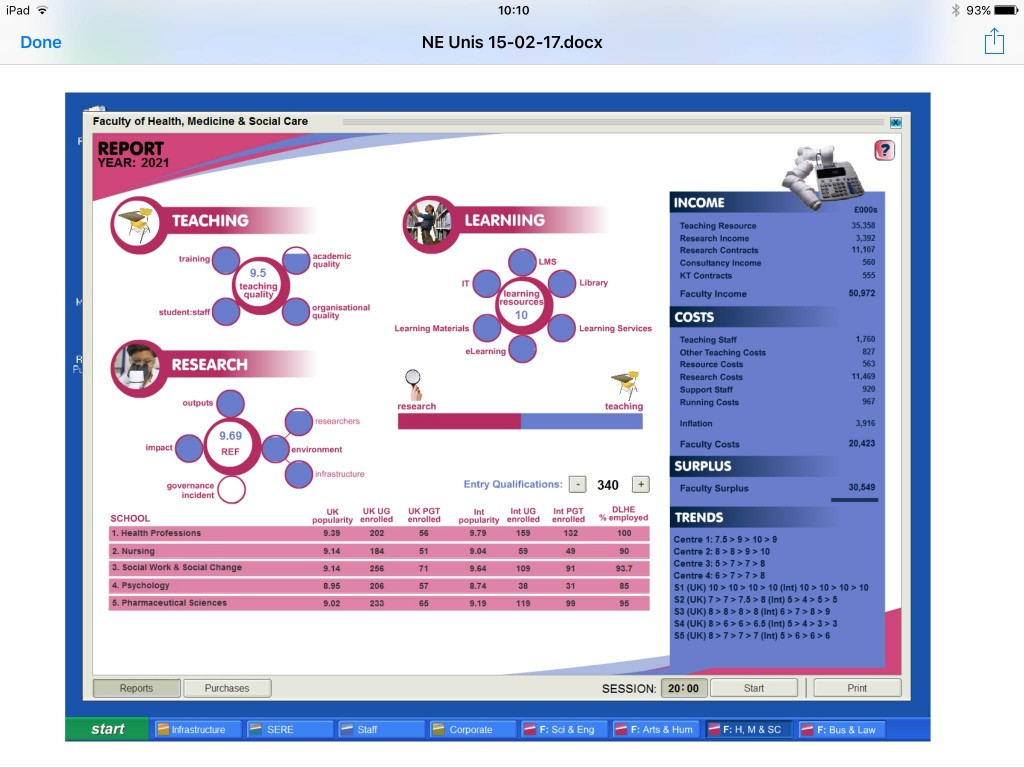Last week several York St John University colleagues and I joined others from the universities of Durham and Newcastle for a shared development session using the Sim-Uni programme. It was the first time I’d used a simulation in a group as a learning tool, although the clever people at Pixel Fountain, who devised the session, have been running them with universities, local authorities and other organisations for a while.
In a nutshell, the roughly 35 of us who attended were split into 8 teams each representing different parts of a university: four faculties and four areas of professional services – HR, corporate, estates and student experience. Our mission was to manage the imaginary university’s spending decisions over a nine year period (three rounds of each three-year student cycle). Each team had a starting budget and a list of spending decisions we could make ourselves, but also had the option of moving money around from one part of the university to another. After each round, all spending decisions were input and the simulator generated new data showing how performance, student attendance and finances at the university had changed as a result, with new budgets then allocated to each team accordingly. The overall effect being a performance map over almost a decade.
It was one of those rare gatherings where a collective conscience across the group seemed to emerge almost immediately. The result of the shared strategy and decisions adopted organically, was one of the highest scores ever achieved by users of the simulation: student numbers soared, income more than doubled and the ‘university’s’ performance went from red to green across the board. We were adamantly assured that this was not normal, with the simulation wired to mirror real life challenges. Given this, we spent some time analysing the source of our success and this presented some thought-provoking learning:
- Lesson 1: Collective investment in the big, cross-cutting organisational challenges works! Often in the game (as in life) teams focus on their own priorities first when it comes to spending. But from the outset each of the four faculties pooled resource into areas of mutual benefit, like student services and workforce development. This meant slower initial growth for the faculties individually, but as the university’s wider challenges were solved more quickly, so performance and popularity soared, bringing much more income for individual teams later in the cycle. Operating as ‘one team’ requires bravery and altruism, but it reaps long-term rewards!
- Lesson 2: The power of respectfully assertive communication. With limited time in each round to shape and make spending decisions it was essential for different teams to collaborate quickly and make their case for moving money around the ‘university’. Office politics took a backseat and instead there were some compelling quick-fire conversations in the room! Consequently, confidence within and across the group grew rapidly and colleagues brought into supporting one another’s shared priorities.
- Lesson 3: Grow gradually to realise longer term ambitions. Perhaps more by coincidence than design, all four faculties took a similar, long term strategy to growth, maintaining a mixed portfolio earlier in the simulation and investing incrementally in areas where rising demand was evident. Whilst there is a case for growing more aggressively (and the simulation may not fully capture the competitiveness of the market), the advantage of a staged approach over a long-term view was that no one part of the university buckled under the pressure of greater numbers meaning the overall student and staff experience consistently improved. When you can take a longer-term view it can pay off to do so.
- Lesson 4: The devil’s in the data. What made Sim-Uni work as an experience was the way the complex data generated by dozens of different spending decisions was presented back to the group so clearly. Diagrams demonstrating performance, trends and numbers combined and clarified what, in the midst of taking part, felt like a multiplicity of different decisions. Put simply: well presented data reaffirmed a collective conscience. In all organisations, but particularly larger ones, using data to tell a single story can be a valuable way to galvanise dispersed teams.
- Lesson 5: The value of an enabling corporate centre. It would have been easy for the corporate team to be seen as a ‘back office’ function, or to act as a gatekeeper within the simulation, but instead that team took on a leadership and enabling role, investing reserves wisely, moving money around imaginatively and spending on good governance to give other teams the right mix of freedoms, support and assurances. The way you want the corporate centre to act!
Taken together these five lessons have given me a timely reminder of some of the big things to keep a focus on as I find my way in a new organisation, whilst the Sim-Uni experience reaffirmed the value of collaboration and seeing the big picture across complex organisations.